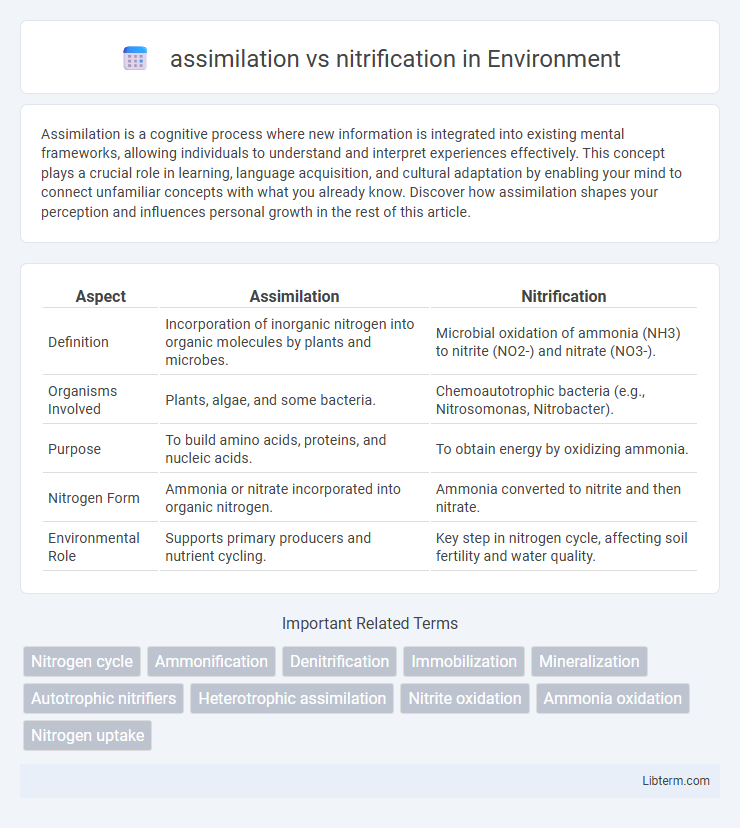Assimilation is a cognitive process where new information is integrated into existing mental frameworks, allowing individuals to understand and interpret experiences effectively. This concept plays a crucial role in learning, language acquisition, and cultural adaptation by enabling your mind to connect unfamiliar concepts with what you already know. Discover how assimilation shapes your perception and influences personal growth in the rest of this article.
Table of Comparison
| Aspect | Assimilation | Nitrification |
|---|---|---|
| Definition | Incorporation of inorganic nitrogen into organic molecules by plants and microbes. | Microbial oxidation of ammonia (NH3) to nitrite (NO2-) and nitrate (NO3-). |
| Organisms Involved | Plants, algae, and some bacteria. | Chemoautotrophic bacteria (e.g., Nitrosomonas, Nitrobacter). |
| Purpose | To build amino acids, proteins, and nucleic acids. | To obtain energy by oxidizing ammonia. |
| Nitrogen Form | Ammonia or nitrate incorporated into organic nitrogen. | Ammonia converted to nitrite and then nitrate. |
| Environmental Role | Supports primary producers and nutrient cycling. | Key step in nitrogen cycle, affecting soil fertility and water quality. |
Introduction to Nitrogen Cycle Processes
Assimilation and nitrification are key nitrogen cycle processes essential for ecosystem nutrient dynamics. Assimilation involves the uptake of inorganic nitrogen compounds, such as ammonium (NH4+) and nitrate (NO3-), by plants to synthesize organic molecules like amino acids. Nitrification is a microbial-mediated oxidation process converting ammonium into nitrite (NO2-) and then to nitrate, which plays a crucial role in nitrogen availability and soil fertility.
Defining Assimilation in the Nitrogen Cycle
Assimilation in the nitrogen cycle involves plants absorbing nitrates or ammonium from the soil and incorporating these nitrogen forms into organic molecules like amino acids and proteins essential for growth. This process contrasts with nitrification, where specific bacteria convert ammonium into nitrites and then nitrates, increasing nitrogen availability but not directly integrating it into biomass. Assimilation is critical for transferring inorganic nitrogen into the living components of the ecosystem, supporting cellular functions and biomass production.
Understanding Nitrification: Stepwise Breakdown
Nitrification is a microbial-driven process converting ammonium (NH4+) into nitrate (NO3-) through two key steps: first, ammonia-oxidizing bacteria (AOB) convert ammonia to nitrite (NO2-), then nitrite-oxidizing bacteria (NOB) oxidize nitrite to nitrate. This biochemical oxidation plays a critical role in the nitrogen cycle by facilitating nitrogen availability in soil and aquatic ecosystems. Assimilation differs by incorporating inorganic nitrogen into organic compounds within plants or microbes, bypassing the oxidation steps characteristic of nitrification.
Key Microorganisms in Assimilation and Nitrification
Key microorganisms involved in assimilation include plants, algae, and various bacteria that incorporate inorganic nitrogen compounds like ammonium and nitrate into organic molecules such as amino acids. In nitrification, specialized chemoautotrophic bacteria such as Nitrosomonas oxidize ammonium to nitrite, while Nitrobacter further oxidizes nitrite to nitrate, playing critical roles in the nitrogen cycle. These distinct microbial groups drive essential biochemical transformations underpinning nitrogen availability and ecosystem productivity.
Chemical Pathways: Assimilation vs. Nitrification
Assimilation incorporates inorganic nitrogen, primarily ammonia or nitrate, into organic molecules such as amino acids through enzymatic reduction and incorporation pathways. Nitrification is a microbial-driven two-step oxidation process converting ammonia to nitrite via ammonia-oxidizing bacteria or archaea, followed by nitrite oxidation to nitrate by nitrite-oxidizing bacteria. These distinct chemical pathways regulate nitrogen availability and form, influencing soil fertility and nitrogen cycling in ecosystems.
Environmental Conditions Influencing Each Process
Assimilation and nitrification are influenced by distinct environmental conditions that affect microbial activity and nutrient cycling. Assimilation thrives under nutrient-rich conditions with adequate organic carbon and oxygen availability, promoting the uptake of ammonium and nitrate by plants and microbes. Nitrification is favored in well-aerated, neutral to slightly alkaline soils with sufficient moisture, enabling chemolithoautotrophic bacteria to oxidize ammonium to nitrate efficiently.
Role in Ecosystem Nitrogen Availability
Assimilation converts inorganic nitrogen compounds like nitrate and ammonium into organic molecules essential for plant and microbial growth, directly influencing nitrogen incorporation into the ecosystem. Nitrification oxidizes ammonium to nitrate, increasing nitrogen mobility and availability but also susceptibility to leaching, thus affecting nitrogen cycling dynamics. Together, these processes regulate the balance of nitrogen forms, maintaining soil fertility and ecosystem productivity.
Human Impact: Agriculture and Waste Management
Agricultural practices heavily influence nitrogen assimilation and nitrification by altering soil microbial activity through the application of synthetic fertilizers and manure, which can increase nitrification rates and lead to elevated nitrate leaching and groundwater contamination. Waste management systems, especially those handling organic waste, impact these nitrogen transformations by promoting either ammonia assimilation by microbes or nitrification, affecting nitrogen retention and atmospheric emissions of nitrous oxide, a potent greenhouse gas. Inefficient management of agricultural runoff and waste treatment can disrupt natural nitrogen cycles, exacerbating eutrophication in aquatic ecosystems and contributing to climate change.
Comparative Benefits and Limitations
Assimilation incorporates inorganic nitrogen into organic compounds, supporting plant growth with direct nutrient uptake, but relies heavily on plant metabolic capacity and environmental conditions. Nitrification converts ammonium to nitrate via chemoautotrophic bacteria, enhancing nitrogen availability in aerobic soils but causing potential nitrate leaching and soil acidification. Assimilation offers immediate incorporation into biomass, whereas nitrification promotes nitrogen cycling but may contribute to environmental nitrogen loss.
Conclusion: Importance of Assimilation and Nitrification
Assimilation and nitrification are essential processes in the nitrogen cycle that sustain ecosystem productivity and soil fertility. Assimilation incorporates inorganic nitrogen into organic compounds used by plants and microorganisms, while nitrification converts ammonia into nitrate, making nitrogen bioavailable for absorption. Their balanced interaction regulates nitrogen availability, influencing agricultural yields and environmental health.
assimilation Infographic

 libterm.com
libterm.com